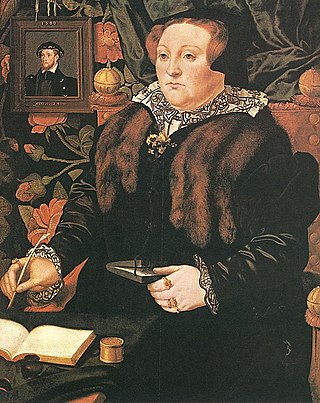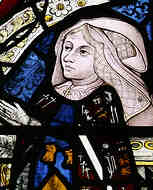Related Research Articles

Baron Dacre is a title that has been created three times in the Peerage of England, every time by writ.

William Paulet, 1st Marquess of Winchester, styled Lord St John between 1539 and 1550 and Earl of Wiltshire between 1550 and 1551, was an English Lord High Treasurer, Lord Keeper of the Great Seal, and statesman.

Thomas Sackville, 1st Earl of Dorset was an English statesman, poet, and dramatist. He was the son of Richard Sackville, a cousin to Anne Boleyn. He was a Member of Parliament and Lord High Treasurer.

Thomas Fiennes, 9th Baron Dacre was an English nobleman notable for his conviction and execution for murder. He was the son of Sir Thomas Fiennes and Jane, daughter of Edward Sutton, 2nd Baron Dudley.
Henry Nevill, de facto 9th Baron Bergavenny was an English iron founder, soldier and politician who sat in the House of Commons at various times between 1601 and 1622 when he inherited the Baron Bergavenny peerage.

Mary Fiennes, Baroness Dacre was the daughter of George Neville, 5th Baron Bergavenny by his third wife, Lady Mary Stafford, youngest daughter of Edward Stafford, 3rd Duke of Buckingham.

Emanuel School is a private, co-educational day school in Battersea, south-west London. The school was founded in 1594 by Anne Sackville, Lady Dacre and Queen Elizabeth I and occupies a 12-acre site close to Clapham Junction railway station.
Joan Dacre, 7th Baroness Dacre was a suo jure peeress of England. She was born in Gilsland, the daughter of Sir Thomas Dacre (1410–1448) and Elizabeth Bowett.
Sir Richard Sackville of Ashburnham and Buckhurst in Sussex and Westenhanger in Kent; was an English administrator and Member of Parliament.
John Sackville MP was a member of parliament for East Grinstead, and a local administrator in Essex, Sussex and Surrey. His first wife was Margaret Boleyn, an aunt of Henry VIII's second Queen, Anne Boleyn, and a great-aunt of Queen Elizabeth I.

Elizabeth Tilney, Countess of Surrey was an English heiress who became the first wife of Thomas Howard, 2nd Duke of Norfolk. She served successively as a lady-in-waiting to two Queen consorts, namely Elizabeth Woodville, wife of King Edward IV, and later as Lady of the Bedchamber to that Queen's daughter, Elizabeth of York, the wife of King Henry VII. She stood as joint godmother to Princess Margaret Tudor at her baptism.

Gregory Fiennes, 10th Baron Dacre was an English courtier.

Robert Sackville, 2nd Earl of Dorset (1561–1609) was an English aristocrat and politician, with humanist and commercial interests.

Sampson Lennard, of Chevening in Kent, was an English Member of Parliament who represented an unusually large number of different constituencies during the reigns of Elizabeth I and James I.
Anne Bourchier, Baroness Dacre was an English noblewoman, the wife of Sir Thomas Fiennes, 8th Baron Dacre. Her stepfather was Thomas Howard, Earl of Surrey, which made Queen consort Anne Boleyn, the second wife of King Henry VIII of England, her niece. Her son-in-law was Henry Norris, who was executed for treason in 1536, as one of the alleged lovers of her niece, Queen Anne.

Margaret Fiennes, 11th Baroness Dacre was a suo jure peeress having been created Baroness Dacre by King James I of England in 1604. She was the daughter of Thomas Fiennes, 9th Baron Dacre who was executed for murder in the year of her birth. His title and lands had been forfeited to the crown. Baroness Margaret's husband was Sampson Lennard MP.

Henry Lennard, 12th Baron Dacre was an English baron and politician. He was the son of Margaret Fiennes, 11th Baroness Dacre and Sampson Lennard.
Sir Nicholas Pelham of Laughton, Sussex was an English politician.
Sir Richard Baker, was an English politician.

Lady Margaret Sackville, formerly Lady Margaret Howard, was the wife of Robert Sackville, 2nd Earl of Dorset.
References
 This article incorporates text from a publication now in the public domain : "Fiennes, Anne". Dictionary of National Biography . London: Smith, Elder & Co. 1885–1900.
This article incorporates text from a publication now in the public domain : "Fiennes, Anne". Dictionary of National Biography . London: Smith, Elder & Co. 1885–1900.